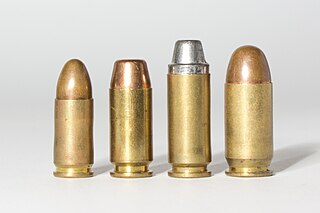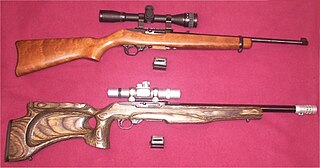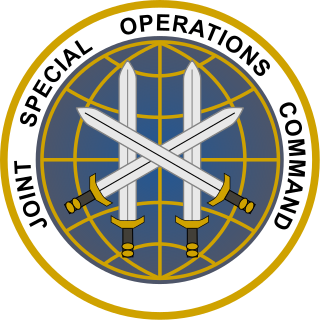Related Research Articles

A firearm is any type of gun that uses an explosive charge and is designed to be readily carried and used by an individual. The term is legally defined further in different countries.

Shooting sports is a group of competitive and recreational sporting activities involving proficiency tests of accuracy, precision and speed in shooting — the art of using ranged weapons, mainly small arms and bows/crossbows.

A hollow-point bullet is a type of expanding bullet which expands on impact with a soft target, transferring more or all of the projectile's energy into the target over a shorter distance.

The .38 Special, also commonly known as .38 S&W Special, .38 Smith & Wesson Special, .38 Spl, .38 Spc, or 9x29mmR is a rimmed, centerfire cartridge designed by Smith & Wesson.

An unmanned combat aerial vehicle (UCAV), also known as a combat drone, colloquially shortened as drone or battlefield UAV, is an unmanned aerial vehicle (UAV) that is used for intelligence, surveillance, target acquisition, and reconnaissance and carries aircraft ordnance such as missiles, ATGMs, and/or bombs in hardpoints for drone strikes. These drones are usually under real-time human control, with varying levels of autonomy. Unlike unmanned surveillance and reconnaissance aerial vehicles, UCAVs are used for both drone strikes and battlefield intelligence.

The .45 ACP, also known as .45 Auto, .45 Automatic, or 11.43×23mm is a rimless straight-walled handgun cartridge designed by John Moses Browning in 1904, for use in his prototype Colt semi-automatic pistol. After successful military trials, it was adopted as the standard chambering for Colt's M1911 pistol. The round was developed due to a lack of stopping power experienced in the Moro Rebellion in places like Sulu. The issued ammunition, .38 Long Colt, had proved inadequate, motivating the search for a better cartridge. This experience and the Thompson–LaGarde Tests of 1904 led the Army and the Cavalry to decide that a minimum of .45 caliber was required in a new handgun cartridge.

The 9×19mm Parabellum is a rimless, centerfire, tapered firearms cartridge.

Accurizing is the process of improving the accuracy and precision of a gun.

Point shooting is a practical shooting method where the shooter points a ranged weapon at a target without relying on the use of sights to aim. Emphasis is placed on fast draw and trying to score preemptive hits first. In close quarters combat, where life-threatening situations emerge very quickly, sighted marksmanship techniques become risky, so advocates of point shooting emphasize a less sighting-oriented style that prioritizes the tactical advantages of quick fire superiority and suppression.
Combat pistol shooting is a modern martial art that focuses on the use of the handgun as a defensive weapon for self defense, or for military and police use. Like most martial arts, combat pistol shooting is practiced both for defense and for sport.

The International Practical Shooting Confederation (IPSC) is the world's largest shooting sport association, and the largest and oldest within practical shooting. Founded in 1976, the IPSC nowadays affiliates over 100 regions from Africa, Americas, Asia, Europe, the Middle East, and Oceania. Competitions are held with pistol, revolver, rifle, and shotgun, and the competitors are divided into different divisions based on firearm and equipment features. While everyone in a division competes in the Overall category, there are also separate awards for the categories Lady, Super Junior, Junior, Senior, and Super Senior.

The Joint Special Operations Command (JSOC) is a joint component command of the United States Special Operations Command (USSOCOM) and is charged with studying special operations requirements and techniques to ensure interoperability and equipment standardization, to plan and conduct special operations exercises and training, to develop joint special operations tactics, and to execute special operations missions worldwide. It was established in 1980 on recommendation of Colonel Charlie Beckwith, in the aftermath of the failure of Operation Eagle Claw. It is headquartered at Pope Field.

Target practice is a key part of both military training and shooting sports. It involves exercises where people shoot weapons at specific targets. The main goal is to improve the shooter's accuracy and skill with firearms. Through repeated practice, participants build essential abilities like aiming, trigger control, and firearm handling. This leads to better overall marksmanship. Target practice also helps assess progress and identify areas for improvement. Ultimately, it's important for both combat effectiveness and success in recreational shooting.

The Smith & Wesson Model 15, initially the Smith & Wesson K-38 Combat Masterpiece, is a six-shot double-action revolver with adjustable open sights produced by Smith & Wesson on the medium-size "K" frame. It is chambered for the .38 Special cartridge and is fitted with a 4-inch (100 mm) barrel, though additional barrel options have been offered at various times during its production. It is essentially a shorter barrel version of the Smith & Wesson Model 14 and an adjustable-sight version of the seminal Smith & Wesson Model 10 with target shooting features.
The modern technique is a method for using a handgun for self-defense, originated by firearms expert Jeff Cooper. The modern technique uses a two-handed grip on the pistol and brings the weapon to eye level so that the sights may be used to aim at the target. This method was developed by Cooper into a teachable system beginning in the 1950s, based on the techniques of shooters like Jack Weaver, Mike Rousseau and others, after experiments with older techniques such as point shooting. The method was codified in book form in 1991 in The Modern Technique of the Pistol by Gregory B. Morrison and Cooper.
The following are terms related to firearms and ammunition topics.
This is a list of aviation-related events from 2015.

On 18 June 2017, a United States Navy F/A-18E shot down a Syrian Air Force Su-22 Fitter with an AIM-120 AMRAAM missile after it reportedly attacked Kurdish Syrian Democratic Forces positions in the town of Ja'Din. It was the first time the U.S. shot down a manned aircraft since 1999 and the first with the F/A-18E/F variant.
Uruguayan law allows firearm possession on shall-issue basis. With approximately 35 civilian firearms per 100 people, Uruguay is the eighth most armed country in the world and most armed in Latin America.
References
- ↑ "GunTec Dictionary". MidwayUSA. Archived from the original on 2008-05-30. Retrieved 2007-09-08.
- 1 2 "A Glossary of Terms Relating to Firearms" . Retrieved 2007-09-08.
- 1 2 Wilson, Sheriff Jim (30 December 2011). "Talking Double". Shooting Illustrated. National Rifle Association of America. Retrieved 28 January 2015.
- ↑ Usher, Jerry (December 2000). "Double Taps". Handguns. 14. 12: 12.
- ↑ Cooper, Jeff (1979). "El Presidente". American Handgunner. 24 (1): 22.
- ↑ Bertomen, Lindsey (November 2007). "An emergency within an emergency". Law Enforcement Technology. 11. 34: 86–89.
- ↑ "Lesson 18. Close Quarters Combat". United States Army. Archived from the original on 19 September 2016. Retrieved 15 September 2016.
- ↑ "Double Tap Strikes: Deliberate Attacks on First Responders in Syria and Yemen – Defenders for Medical Impartiality". defendmedicalimpartiality.org. Retrieved 2018-08-10.
- ↑ Woods, Chris; Yusufzai, Mushtaq (August 1, 2013). "Drone strikes in Pakistan -- Get the Data: The return of double-tap drone strikes". The Bureau of Investigative Journalism. Archived from the original on 7 August 2015. Retrieved 24 August 2015.
- ↑ Julian Thompson; Marius Rehn; Hans Morten Lossius; David Lockey (24 September 2014). "Risks to emergency medical responders at terrorist incidents: a narrative review of the medical literature". Critical Care. 18 (5): 521. doi: 10.1186/s13054-014-0521-1 . PMC 4422304 . PMID 25323086.
- ↑ "Secondary Devices a Primary Concern | Office of Justice Programs". www.ojp.gov. Retrieved 2023-08-09.
- ↑ Alexander, Samuel (2018-02-21). "Double-Tap Warfare: Should President Obama Be Investigated for War Crimes?". Florida Law Review. 69 (1): 261. ISSN 1045-4241.
- ↑ Dehghan, Saeed (16 September 2016). "'After an hour the plane came back': repeated airstrikes take toll on Yemeni civilians". theguardian.com.
- ↑ "The Human Rights Abuses in Yemen's "Forgotten War"". Time. 2016-10-12. Retrieved 2023-08-08.
- ↑ Taylor, Jerome (2012-09-25). "Outrage at CIA's deadly 'double tap' drone". London: Independent. Retrieved 2013-05-25.
- ↑ Friedersdorf, Conor (2013-10-24). "Drone Attacks at Funerals of People Killed in Drone Strikes". The Atlantic. Retrieved 2019-04-29.
- ↑ "Drones kill rescuers in 'double tap', say activists". BBC News. 2013-10-22. Retrieved 2021-02-21.
- ↑ Bachmann, Jutta; Baldwin-Ragaven, Laurel; Hougen, Hans-Petter; Leaning, Jennifer; Kelly, Karen; Özkalipci, Önder; Reynolds, Louis; Vacas, Alicia (January 20, 2015). "Gaza 2014 - Findings of an Independent Medical Fact-Finding Mission" (PDF). Physicians for Human Rights Israel. Retrieved 24 August 2015.
- ↑ "Idlib 'double tap' air strikes: Who's to blame?". BBC News. Retrieved 2019-08-31.
- ↑ Parker, Claire (2022-07-22). "Russia and Syria conducted dozens of illegal 'double tap' strikes, report says". Washington Post. ISSN 0190-8286 . Retrieved 2023-08-08.
- ↑ Epstein, Jake. "Russia is bombing the same targets moments apart to kill Ukrainian rescue crews that arrive to save survivors". Business Insider. Retrieved 2023-08-08.